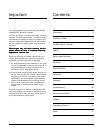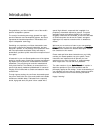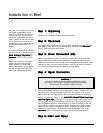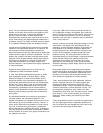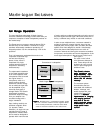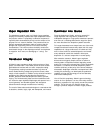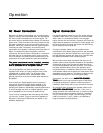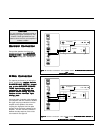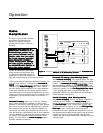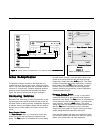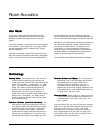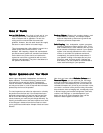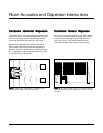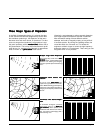
Page 10
Quest User's Manual
Operation
AC Power ConnectionAC Power Connection
AC Power ConnectionAC Power Connection
AC Power Connection
Because your Martin-Logan Quests
use an internal power
supply to energize their electrostatic cells with high-voltage
DC, they must be connected to an AC power source. For
this reason they are provided with the proper IEC standard
power cords. These cords should be firmly inserted into the
AC power receptacles on the rear connection panel of the
speakers, then to any convenient AC wall outlet. Extension
cords may be used, if necessary, since the AC power
requirement of the speaker is extremely small (less than 2.5
watts). The Quests have been designed to remain on
continuously and should remain connected to a continuous
AC power source. As mentioned earlier, power consump-
tion of the Quest is very small and the life expectancy of its
components will not be reduced by continuous operation.
The power cord should not be installed, removed,The power cord should not be installed, removed,
The power cord should not be installed, removed,The power cord should not be installed, removed,
The power cord should not be installed, removed,
or left detached from the speaker while the otheror left detached from the speaker while the other
or left detached from the speaker while the otheror left detached from the speaker while the other
or left detached from the speaker while the other
end is connected to an AC power source.end is connected to an AC power source.
end is connected to an AC power source.end is connected to an AC power source.
end is connected to an AC power source.
Your Quest speakers are wired for the power service
supplied in the country of original consumer sale unless
manufactured on special order. The AC power rating
applicable to a particular unit is specified both on the
packing carton and on the serial number plate attached to
the speaker.
If you remove your Quest speakers from the country of
original sale, be certain that AC power supplied in any
subsequent location is suitable before connecting and
operating the speakers. Substantially impaired performance
or severe damage may occur to a Quest speaker if opera-
tion is attempted from an incorrect AC power source.
If your home is not equipped with three-prong wall outlets,
you may use “cheater” plugs to connect the speakers to
AC power. These may be obtained at your dealer or any
hardware department.
Signal ConnectionSignal Connection
Signal ConnectionSignal Connection
Signal Connection
Use the best speaker cables you can! The length and type
of speaker cable used in your system will have an audible
effect. Under no circumstance should a wire of gauge
higher (thinner) than #16 be used. In general, the longer the
length used, the greater the necessity of a lower gauge, and
the lower the gauge, the better the sound, with diminishing
returns setting in around #8 to #12.
A variety of speaker cables are now available whose
manufacturers claim better performance than with standard
heavy gauge wire. We have verified this in some cases, and
the improvements available are often more noticeable than
the differences between wires of different gauge.
We would also recommend, if possible, that short runs of
speaker cable connect the power amplifier(s) and speakers
and that high quality long interconnect cables be used to
connect the preamplifier and power amplifier. This results in
the power amplifiers being close to the speakers, which
may be practically or cosmetically difficult, but if the length
of the speaker cables can be reduced to a few meters, sonic
advantages may be obtained. The effects of cables may be
masked if the equipment is not of the highest quality.
Connections are done at the
AMPLIFIER CONNEC-AMPLIFIER CONNEC-
AMPLIFIER CONNEC-AMPLIFIER CONNEC-
AMPLIFIER CONNEC-
TIONSTIONS
TIONSTIONS
TIONS section on the rear electronics panel of the Quest.
Use spade connectors for optimum contact and ease of
installation. Make certain that all your connections are tight.
Be consistent when connecting the speaker cables to the
AMPLIFIER CONNECTIONS AMPLIFIER CONNECTIONS
AMPLIFIER CONNECTIONS AMPLIFIER CONNECTIONS
AMPLIFIER CONNECTIONS terminals. Take care to
assign the same color cable lead to the (+) terminal on both
the left and right channel speakers. If bass is nonexistent
and you cannot discern a tight, coherent image, you may
need to reverse the (+) and (-) leads on one speaker to
bring the system into proper polarity.



